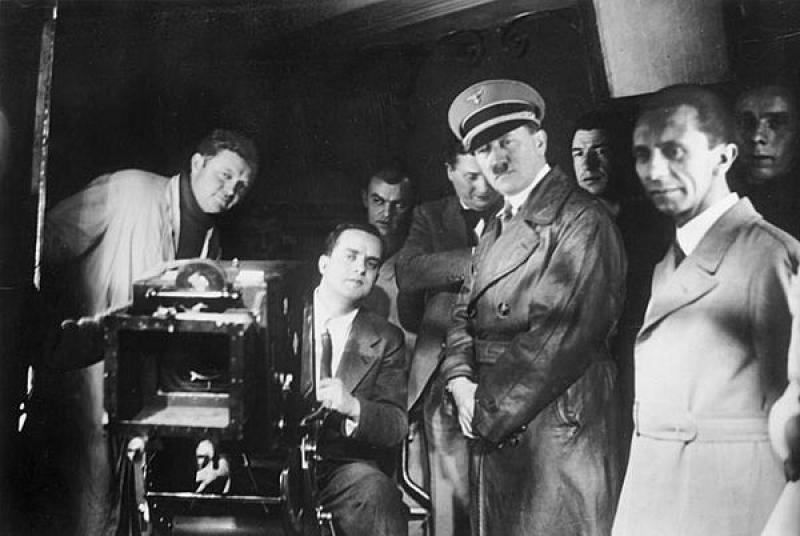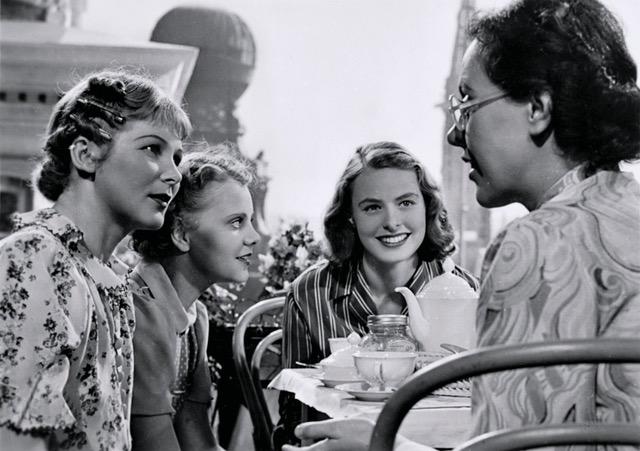DVD/Blu-ray: Hitler's Hollywood | reviews, news & interviews
DVD/Blu-ray: Hitler's Hollywood
DVD/Blu-ray: Hitler's Hollywood
Unwrapping the sugar-coated cover-up that was Nazi cinema

Apart from Leni Riefenstahl’s insidiously seductive celebrations of Nazism and the propaganda excesses of Veit Harlan’s Jud Süß (1940), the films that were made in Germany during the Hitler period have been air
Director Rüdiger Suchsland had previously made a film about German cinema during the Weimar years, which is usefully included as a bonus with this release. The years 1933-1945 do not offer such ground-breaking works as Fritz Lang’s Metropolis or M: the Hitler years were not about experimentation or radical social commentary. Once the Nazis applied the policy of Gleichschaltung from 1933 on, the cinema industry was brought under the almost total control of the UFA studios, which were nationalised. All scripts were vetted by the Ministry of Culture and Propaganda and passed through the hands of the minister Joseph Goebbels.
The images in the Nazi-period films are very seductive indeed
The commentary-driven documentary, very conventional in form – but maybe the subject demands this – suggests that a survey of the films from this period will reveal something about the undercurrents of German life at the time, as if unconscious drives might become more visible. To some extent Suchsland manages this, although much is left to the imagination. Aided by quotes from Hannah Arendt, Susan Sontag, Siegfried Kracauer (and Goebbels himself), he suggests that propaganda is all about enchantment. There is a remarkable clip from GW Pabst’s Nazi-period film Paracelsus (1943): a crowd is gradually mesmerised and possessed into a crazy collective dance by a hippieish prophet and healer. It could be construed as being about the enchantment of the German masses by Hitler as much as about a Nazi view of the hypnotic malevolence of the Jew. The film is full of such paradoxes.
The documentary provides a catalogue of different genres, very thorough but ultimately without sufficient variation in pace. The cinema of this dark period of German history is mostly bright and cheerful, not to say absurdly sugar-coated, all about keeping people’s minds as far away from reality as possible, with tales of heroism and romance, and visual techniques including super-imposition, blurred images and a dream-like quality to the fore. Might it not have been more disturbing to juxtapose this almost absurd fantasy world with the terrible realities of political repression, total war and mass extermination? Perhaps too facile a solution, that might have been construed as counter-propaganda or agitprop, but the absence of these very dark realities does at times feel like denial, in spite of a commentary that touches on the history of the period – but in a rather detached way. In the context of film, images speak louder than words and the images in these Nazi period films are very seductive indeed – as they were meant to be. No amount of commentary and deconstruction can counteract the power with which they were originally endowed: the beautiful stars, style borrowed from Hollywood – Hitler was a great movie enthusiast and loved the comedies of Frank Capra – and very assured technique. These fascinate, and just one image of the liberation of Belsen might have made the terrifying masquerade of Nazi cinema all the more tangible.
Perhaps too facile a solution, that might have been construed as counter-propaganda or agitprop, but the absence of these very dark realities does at times feel like denial, in spite of a commentary that touches on the history of the period – but in a rather detached way. In the context of film, images speak louder than words and the images in these Nazi period films are very seductive indeed – as they were meant to be. No amount of commentary and deconstruction can counteract the power with which they were originally endowed: the beautiful stars, style borrowed from Hollywood – Hitler was a great movie enthusiast and loved the comedies of Frank Capra – and very assured technique. These fascinate, and just one image of the liberation of Belsen might have made the terrifying masquerade of Nazi cinema all the more tangible.
Suchsland provides a useful introduction and compendium, and the clips are long enough to really make their point. The cinema of the period didn’t exist in a bubble, and those who were involved continued in films after the end of the war: Ingrid Bergman played her first leading role at 23 in Die Vier Gesellen (1938, pictured above), and never spoke about it in later years. Douglas Sirk, the master of melodrama, cut his teeth in Germany as Detlef Sierck, and Veit Harlan, who made the horrific Jud Süß – Suchsland says that it provided a rationale for the mass murder of the Jews – claimed he was forced to make the film and continued working long after 1945.
Perhaps most extraordinary are the filmmakers who managed to make work that avoided being about keeping the lies of the regime afloat; films that suggested alternatives with quiet radicalism such as Großstadtmelodie by Wolfgang Liebeneiner (1942), all about an independently minded woman who refuses to be tied to the kitchen and becomes a photographer; or Herman Käutner’s Vater der Brücken (1944), which was banned as it dealt with the lives of individuals rather than the sweep of communal enthusiasm or patriotism. Käutner, according to Suchsland the greatest filmmaker of the period, somehow managed to work under the radar, although his celebrated musical Grosse Freiheit (1944) fell victim to the censors and wasn’t shown until after the Allied defeat of Germany in 1945.
This cinema is all about dream and fantasy, a perfect tool for propaganda and a kind of mass hypnotism. The stars are objects for projection and near-fanatical obsession. What this documentary doesn’t touch is the difficult and complex relationship between commercial and mass-audience cinema in general with a kind of pacification of the mind, an escapism that reduces the capacity of individuals to find their own truth. This has been true of cinema from its very beginning. If bums-on-seats and profit rule, this extraordinarily powerful tool can shape the unconscious of the audience and lull viewers into a kind of feel-good trance. Bread and circuses are a perfect means for keeping the masses from asking too many questions, let alone taking action to make significant change.
rating
Share this article
The future of Arts Journalism
You can stop theartsdesk.com closing!
We urgently need financing to survive. Our fundraising drive has thus far raised £49,000 but we need to reach £100,000 or we will be forced to close. Please contribute here: https://gofund.me/c3f6033d
And if you can forward this information to anyone who might assist, we’d be grateful.

Subscribe to theartsdesk.com
Thank you for continuing to read our work on theartsdesk.com. For unlimited access to every article in its entirety, including our archive of more than 15,000 pieces, we're asking for £5 per month or £40 per year. We feel it's a very good deal, and hope you do too.
To take a subscription now simply click here.
And if you're looking for that extra gift for a friend or family member, why not treat them to a theartsdesk.com gift subscription?
more Film
 Can I get a Witness? review - time to die before you get old
Ann Marie Fleming directs Sandra Oh in dystopian fantasy that fails to ignite
Can I get a Witness? review - time to die before you get old
Ann Marie Fleming directs Sandra Oh in dystopian fantasy that fails to ignite
 Happyend review - the kids are never alright
In this futuristic blackboard jungle everything is a bit too manicured
Happyend review - the kids are never alright
In this futuristic blackboard jungle everything is a bit too manicured
 Robert Redford (1936-2025)
The star was more admired within the screen trade than by the critics
Robert Redford (1936-2025)
The star was more admired within the screen trade than by the critics
 Blu-ray: The Sons of Great Bear
DEFA's first 'Red Western': a revisionist take on colonial expansion
Blu-ray: The Sons of Great Bear
DEFA's first 'Red Western': a revisionist take on colonial expansion
 Spinal Tap II: The End Continues review - comedy rock band fails to revive past glories
Belated satirical sequel runs out of gas
Spinal Tap II: The End Continues review - comedy rock band fails to revive past glories
Belated satirical sequel runs out of gas
 Downton Abbey: The Grand Finale review - an attemptedly elegiac final chapter haunted by its past
Noel Coward is a welcome visitor to the insular world of the hit series
Downton Abbey: The Grand Finale review - an attemptedly elegiac final chapter haunted by its past
Noel Coward is a welcome visitor to the insular world of the hit series
 Islands review - sunshine noir serves an ace
Sam Riley is the holiday resort tennis pro in over his head
Islands review - sunshine noir serves an ace
Sam Riley is the holiday resort tennis pro in over his head
 theartsdesk Q&A: actor Sam Riley on playing a washed-up loner in the thriller 'Islands'
The actor discusses his love of self-destructive characters and the problem with fame
theartsdesk Q&A: actor Sam Riley on playing a washed-up loner in the thriller 'Islands'
The actor discusses his love of self-destructive characters and the problem with fame
 Honey Don’t! review - film noir in the bright sun
A Coen brother with a blood-simple gumshoe caper
Honey Don’t! review - film noir in the bright sun
A Coen brother with a blood-simple gumshoe caper
 The Courageous review - Ophélia Kolb excels as a single mother on the edge
Jasmin Gordon's directorial debut features strong performances but leaves too much unexplained
The Courageous review - Ophélia Kolb excels as a single mother on the edge
Jasmin Gordon's directorial debut features strong performances but leaves too much unexplained
 Blu-ray: The Graduate
Post #MeToo, can Mike Nichols' second feature still lay claim to Classic Film status?
Blu-ray: The Graduate
Post #MeToo, can Mike Nichols' second feature still lay claim to Classic Film status?
